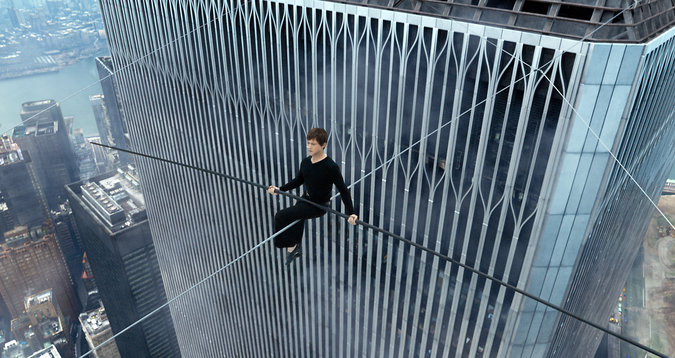
By Daniela Coe-Mcnamara
Staff Writer
A French street performer balancing on a wire between the two tallest buildings in the world sounds like a compelling story that would put viewers on the edge of their seats. “The Walk” nearly succeeded in this depiction, but it veered towards uncharted territory with distracting narration.
The breathtaking visuals, appreciation for street performances, and vividly detailed, nerve wracking scenes in “The Walk” draw the audience into the story. Only, every few minutes, immersion is broken as Joseph Gordon-Levitt stands atop the Statue of Liberty, acting as an unnecessary guide in the story.
Directed by Robert Zemeckis, renowned director of “Forrest Gump” and “Back to the Future,” “The Walk” tells the true story of Frenchman Philippe Petit (Joseph Gordon-Levitt) and his walk between the Twin Towers on August 7th, 1974. In the film, Philippe is determined to make this dangerous walk, despite the endless stream of doubt that comes at him from all sides.
The story of Philippe Petit’s obsession with walking between the two towers is narrated by Philippe, who is, for some unknown reason, standing on the Statue of Liberty, giving the film the appearance of an educational video. The film zooms in and out, switching from voice over narration back to full immersion in the story, a distracting element that “The Walk” would have done better without.
Zemeckis undeniably succeeds in his digital recreation of the Twin Towers, a wonderful blend of technology and history that reminds audiences of the magnificence of the two towers. Philippe was said to bring the towers to life on that day in 1974, a quarter of a century before the tragic collapse in 2001, and Zemeckis effectively brings their legacy back to life in this memorialization.
One of the most clearly emphasized aspects of “The Walk” are its dramatic visuals, including the chill-inducing walk across the fated wire, which is partly computer animated. The immaculate detail, such as the steel cable, swaying in the gusts of wind, magnifies the suspense Philippe Petit experiences in “the void,” transporting audiences 1,360 feet above ground.
Released initially in IMAX 3D theaters, the stereoscopic effect adds intensity to the shocking yet beautiful story of Philippe and his walk. Although the 3D glasses blur the picture at times, the booming surround sound and intense 3D imaging viewed in IMAX theaters strengthens the dramatic visuals of the film.
The film’s storyline follows the true story, but stresses the importance of street performers in a way that previous adaptations failed. The beauty of the walk, despite its illegality, has an unconventional allure because of the raw talent involved, like so many other street performances. The film aims to emphasize the value of the aesthetic aspect of street performers, who are so underappreciated for their engaging performances.
Another aspect that is clearly emphasized in the second half of the film is “the coup,” or the heist, as it brings about the argument of whether something done for art should be considered illegal. Philippe Petit’s walk did not harm anyone, besides risking his own life, yet as he balances on the wire, he faces police officers on either side. The moral question woven throughout the film argues that, for aesthetics sake, the walk is of no harm to others, besides putting the audience on the edge of their seats.
While succeeding in its spectacular, close up shots, emphasis on the artistic side of the walk, and revival of the Twin Towers, the success of “The Walk” is deterred only by its distracting element of narration. The film is available in IMAX, 3D, and regular viewing at theaters nearby.




Leave a Reply